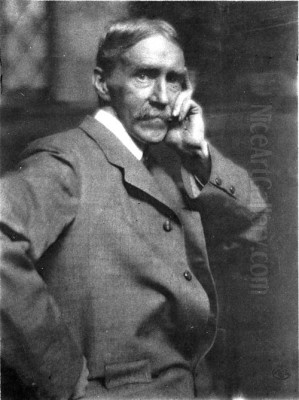
Maurice Brazil Prendergast stands as a unique and pivotal figure in the history of American art. Active during a period of profound transition, bridging the 19th and 20th centuries, he forged a distinctive style that absorbed the lessons of European Post-Impressionism while depicting the burgeoning energy of modern American life. Known for his vibrant, mosaic-like compositions filled with figures enjoying moments of leisure, Prendergast was an artist who celebrated color, pattern, and the spectacle of the everyday. Though associated with progressive art groups of his time, his singular vision set him apart, making him a crucial link between earlier traditions and the advent of American Modernism.
Early Life and Artistic Beginnings
Maurice Brazil Prendergast was born on October 10, 1858, in St. John's, Newfoundland, which was then a British colony. His family, including his twin sister Lucy and younger brother Charles, moved to the South End of Boston, Massachusetts, around 1868. His father, also named Maurice, struggled to establish a successful trading post, leading to financial instability for the family. This economic pressure meant that formal education for the Prendergast children was limited. Maurice left school early to contribute to the family income.
His artistic inclinations surfaced early. As a teenager, he worked wrapping packages at a dry goods store, but his interest lay elsewhere. Around the age of 18, he began working in the field of commercial art, specifically lettering and creating "show cards" – essentially advertisements and announcements. This practical experience, though not fine art training, likely honed his sense of design, composition, and the effective use of visual elements. It was a common starting point for many artists of the era, providing a foundation in visual communication before they pursued more personal artistic paths.

During these formative years in Boston, he developed a close bond with his younger brother, Charles Prendergast. Charles would also become an artist, known particularly for his unique carved, gessoed, and painted panels and frames, often collaborating with Maurice later in life. Their shared artistic interests and mutual support would be a constant throughout their careers. Despite the lack of formal art schooling in his youth, Maurice sketched avidly, particularly during a trip to Britain with Charles around 1886, absorbing the sights and honing his observational skills.
The Parisian Transformation
The turning point in Prendergast's artistic development came in 1891 when, at the relatively mature age of 32, he traveled to Paris for formal art training, funded perhaps by savings and possibly support from his brother. Paris was the undisputed center of the art world, a crucible of tradition and radical innovation. Prendergast immersed himself in this environment for approximately three years, studying diligently at several prestigious ateliers.
He enrolled first at the Académie Colarossi, known for its less rigid approach compared to the official École des Beaux-Arts. Later, he attended the Académie Julian, another popular destination for foreign students, including many Americans. These academies provided essential training in drawing from the live model and mastering academic techniques. However, perhaps more influential than the formal instruction was the vibrant artistic milieu of Paris itself. Prendergast was exposed firsthand to the revolutionary movements that had reshaped European art.
He absorbed the lessons of Impressionism, particularly the work of artists like Edgar Degas and Camille Pissarro, who captured fleeting moments of modern life with innovative compositions and attention to light. Even more significantly, he encountered Post-Impressionism. The structural concerns of Paul Cézanne, the bold colors and expressive forms of Vincent van Gogh and Paul Gauguin, and the decorative, flattened patterns of the Nabis group, including Pierre Bonnard and Édouard Vuillard, left a profound mark on his developing aesthetic. He also admired the work of James Abbott McNeill Whistler, an American expatriate whose tonal harmonies and elegant compositions resonated with him.
His time in Paris was not just about study; it was about observation and experience. He sketched constantly in the cafes, parks, and boulevards, capturing the rhythm and energy of the city. He frequented galleries and exhibitions, engaging with the latest artistic trends. This period transformed Prendergast from a commercially trained artist into a painter with a sophisticated understanding of contemporary European art and the beginnings of his own unique voice. He returned to Boston around 1895, equipped with new techniques and a modern sensibility.
Developing a Unique Vision: Style and Technique
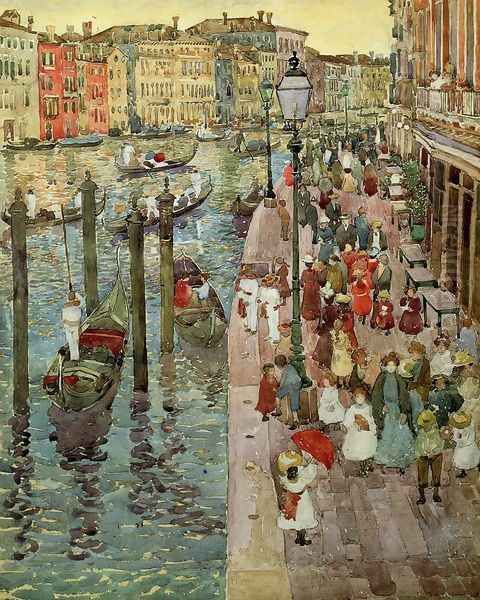
Upon returning from Paris, Prendergast began to synthesize his experiences and forge a style that was distinctly his own. While rooted in Post-Impressionist principles, his work evolved into something unique within the American art landscape. His mature style is often described as resembling a mosaic or a tapestry, characterized by vibrant colors, flattened perspectives, and intricate patterns formed by figures and their surroundings.
Color was paramount for Prendergast. He employed a bright, often jewel-like palette, applying paint in short, distinct strokes or dabs. These patches of color, placed side-by-side, create a shimmering, vibrant surface. He wasn't primarily concerned with naturalistic representation of light and shadow in the Impressionist sense; instead, he used color to build form, create rhythm, and evoke a joyful, decorative effect. His compositions often flatten the pictorial space, minimizing traditional perspective and emphasizing the surface pattern, a quality likely influenced by the Nabis painters and Japanese prints.
His brushwork is characteristic – often short, deliberate strokes that define form and texture simultaneously. In his oils, these strokes build up into a rich, textured surface. Figures are often simplified, sometimes appearing almost like cut-outs arranged across the canvas, contributing to the overall decorative scheme rather than serving as deep psychological portraits. The effect is less about individual narrative and more about the collective energy and visual rhythm of the scene.
Prendergast was exceptionally skilled in watercolor, a medium he used throughout his career with great fluency and sensitivity. His watercolors, particularly those from his trips to Venice, are celebrated for their luminosity and spontaneity. He exploited the transparency of the medium to capture the dazzling light and reflections of the city. He was also a master of the monotype, a printmaking technique that yields a single, unique impression. His monotypes often possess a painterly quality, exploring themes similar to his paintings but with the distinct textures and effects inherent in the printing process.
Themes of Leisure and Modernity
Prendergast's primary subject matter was the spectacle of modern life, particularly people enjoying moments of leisure in public spaces. He was drawn to scenes of collective activity and visual richness, capturing the burgeoning urban and seaside culture of the late 19th and early 20th centuries. His canvases and watercolors teem with life, depicting crowds gathered in city parks, strolling along promenades, or relaxing at beach resorts.

Boston Common and Central Park in New York were frequent subjects, providing stages for his observations of elegantly dressed women with parasols, children playing, and the general ebb and flow of urban recreation. He rendered these scenes not with the gritty realism favored by some of his contemporaries, but with an eye for pattern, color, and the overall festive atmosphere. His figures often seem anonymous, part of a larger human tapestry rather than individuals with specific stories. This approach emphasizes the visual experience of the crowd and the environment itself.
Seaside resorts like Nahant and Revere Beach near Boston also provided rich material. He captured the bright sunlight, the colorful beach attire, the movement of waves, and the relaxed postures of vacationers. These works convey a sense of idyllic escape and the simple pleasures of modern leisure. Again, the focus is on the overall visual harmony and decorative potential of the scene, transforming everyday moments into vibrant, patterned compositions.
His two extended trips to Italy, particularly Venice (1898-1899 and 1911-1912), were immensely productive and resulted in some of his most celebrated works. Venice, with its unique light, reflective water, intricate architecture, and festive atmosphere, was perfectly suited to his artistic temperament. He produced numerous watercolors and oils capturing gondolas on the Grand Canal, crowds in St. Mark's Square, and figures crossing bridges. Works like Umbrellas in the Rain, Venice exemplify his ability to turn even an inclement day into a study of pattern and shimmering color. These Italian scenes solidified his reputation and showcased his mastery of capturing complex, animated environments.
Prendergast and The Eight
In 1908, Prendergast participated in a landmark exhibition that would cement his place in the narrative of progressive American art. He was invited to join a group of artists, later famously known as "The Eight," for a show at the Macbeth Galleries in New York City. The exhibition was organized primarily as a protest against the conservative exhibition policies of the National Academy of Design, which tended to favor academic styles and reject more modern or unconventional work.
The core members of The Eight were associated with the Ashcan School, led by the influential teacher and painter Robert Henri. This group included John Sloan, William Glackens, George Luks, and Everett Shinn, artists known for their realistic, often gritty depictions of urban life in New York City. The other members were Ernest Lawson, an Impressionist landscape painter, Arthur B. Davies, whose work leaned towards symbolism and idyllic themes, and Maurice Prendergast.
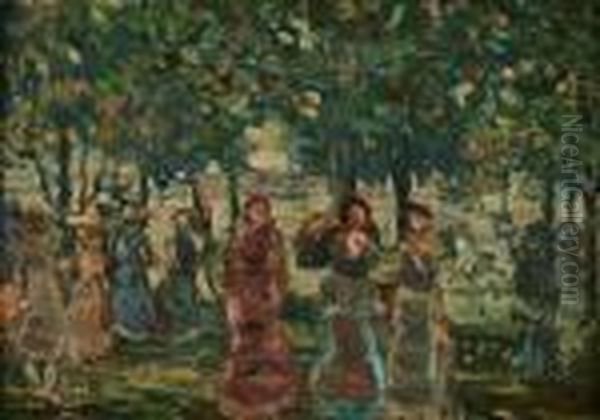
While united by their opposition to the Academy and their desire for artistic independence, The Eight were stylistically diverse. Prendergast's inclusion is particularly interesting because his aesthetic differed significantly from the urban realism of Henri and his followers. Prendergast's focus was not on social commentary or the harsh realities of city life, but on the decorative beauty, color, and pattern found in scenes of leisure. His style, heavily influenced by European Post-Impressionism and the Nabis, emphasized formal qualities and aesthetic harmony over narrative or realism.
Despite these stylistic differences, Prendergast shared with the other members of The Eight a commitment to modern subjects and an independent spirit. His participation in the 1908 exhibition aligned him with the progressive forces in American art. The show was a critical success and a significant event, challenging the established art institutions and paving the way for greater acceptance of diverse artistic approaches in the United States. It brought Prendergast increased visibility, particularly in New York, although his unique style continued to set him apart from the dominant trends of American realism.
The Armory Show and Wider Recognition
Five years after the exhibition of The Eight, Prendergast participated in another, even more revolutionary event: the International Exhibition of Modern Art, better known as the Armory Show, held in New York City in 1913. This massive exhibition was a watershed moment in American art history, introducing the American public and artists to the radical developments of the European avant-garde on an unprecedented scale. Works by artists like Henri Matisse, Pablo Picasso, Marcel Duchamp, Wassily Kandinsky, and Constantin Brancusi shocked and bewildered many, but also profoundly influenced the course of American art.
Prendergast exhibited seven works at the Armory Show, including oils and watercolors. By this time, his style, while still unique, was perhaps less shocking than the Fauvist, Cubist, and Futurist works from Europe. However, his inclusion placed him firmly within the context of international modernism. His emphasis on color, pattern, and flattened form resonated with the formal innovations being explored by European artists, even though his subject matter remained focused on pleasant scenes of modern life rather than the more abstract or psychologically charged themes of some avant-garde movements.
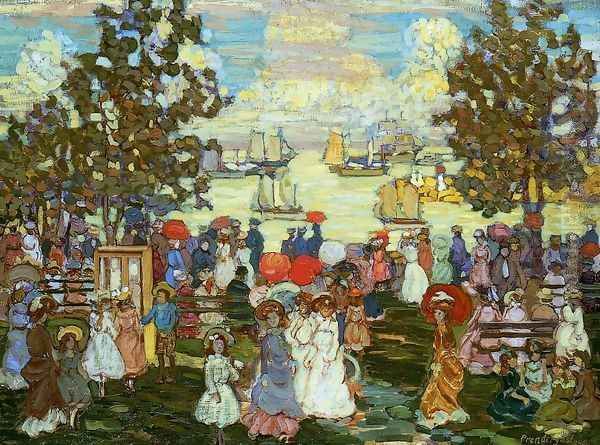
The Armory Show generated enormous publicity and debate, significantly raising the profile of modern art in America. For Prendergast, it provided further validation and exposure on a national stage. His work was seen alongside the most talked-about art of the day, solidifying his reputation as a significant American modernist. While some critics continued to find his style decorative or superficial, others recognized its sophistication and originality. The exhibition helped to create a more receptive environment for artists like Prendergast who were exploring alternatives to academicism and realism.
Following the Armory Show, Prendergast's reputation continued to grow. He moved from Boston to New York City in 1914, settling near Washington Square. He exhibited regularly, and his work began to be acquired by important collectors and museums. Though never achieving the widespread fame of some contemporaries, he earned the respect of fellow artists, critics, and curators who appreciated his unique contribution to American painting.
Key Works and Masterpieces
Throughout his career, Prendergast created a body of work marked by consistent stylistic development and thematic focus. Several paintings and watercolors stand out as particularly representative of his artistic achievements.
_Umbrellas in the Rain, Venice_ (c. 1899, Museum of Fine Arts, Boston): This celebrated watercolor captures a bustling Venetian scene under overcast skies. Prendergast transforms the potentially dreary subject into a vibrant pattern of colorful umbrellas, reflections on the wet pavement, and figures huddled against the weather. It showcases his mastery of watercolor, his ability to find decorative potential in everyday life, and his fascination with the unique atmosphere of Venice.
_The Grand Canal, Venice_ (c. 1898-99, Smithsonian American Art Museum): Another iconic Venetian watercolor, this work depicts the famous waterway teeming with gondolas and lined with palazzi. Prendergast uses fluid washes and dabs of bright color to convey the shimmering light, the movement of water, and the festive energy of the city. The composition is complex yet harmonious, demonstrating his skill in organizing numerous elements into a cohesive whole.
_Central Park_ (various versions, e.g., 1901, Whitney Museum of American Art): Prendergast returned frequently to the theme of Central Park. These works, often watercolors or monotypes in his earlier period, capture the leisurely pace of life in the park – nursemaids with children, couples strolling, people relaxing on benches. He uses broken color and simplified forms to suggest the dappled sunlight and the movement of figures within the landscape.
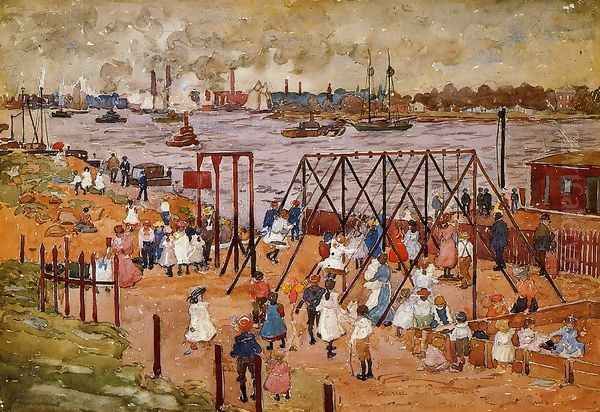
_Sunday in the Park_ (c. 1910-1913, location varies/private collections): This title applies to several later oil paintings depicting crowded park scenes, likely inspired by Central Park or similar urban oases. These works exemplify his mature oil technique, with densely packed compositions, rich textures built from distinct brushstrokes, and a flattened, tapestry-like effect. Figures merge into a vibrant mosaic of color and pattern, celebrating the collective experience of public leisure.
_The Promenade_ (c. 1913, Detroit Institute of Arts): This oil painting is characteristic of his later style, depicting elegantly dressed figures strolling, likely along a seaside path. The forms are simplified and flattened, arranged in rhythmic patterns across the canvas. The emphasis is on the decorative interplay of color and shape, creating a joyful, almost dreamlike vision of modern elegance.
_The Eight Bathers_ (c. 1916-18, location varies/private collections): In his later years, Prendergast explored more Arcadian themes, often featuring bathers in idyllic landscapes. These works show the continued influence of Cézanne, particularly his bather compositions, in their structured forms and monumental quality. However, Prendergast retains his characteristic emphasis on color and pattern, creating decorative arrangements rather than naturalistic scenes.
These works, among many others, demonstrate Prendergast's consistent artistic vision: a celebration of modern life rendered through a unique lens of color, pattern, and flattened form, bridging the gap between Post-Impressionism and early American Modernism.
Later Years and Artistic Evolution
In 1914, Maurice Prendergast, along with his brother Charles, moved from Boston to New York City, settling at 50 Washington Square South. This move placed him closer to the center of the burgeoning American modern art scene, although he remained a somewhat reserved figure, dedicated primarily to his work. His studio became a gathering place for friends and fellow artists, but he largely avoided the political maneuvering of the art world.
During his later years, Prendergast continued to refine his distinctive style, working primarily in oil. His compositions became increasingly dense and complex, often resembling intricate tapestries woven from patches of vibrant color. While he continued to paint scenes of parks and beaches, he also explored more imaginative and Arcadian themes, such as processions, fêtes, and groups of bathers in idealized landscapes. These later works often feature more stylized, elongated figures and show a continued engagement with the formal innovations of European modernists like Matisse and the lingering influence of Cézanne's structural approach.
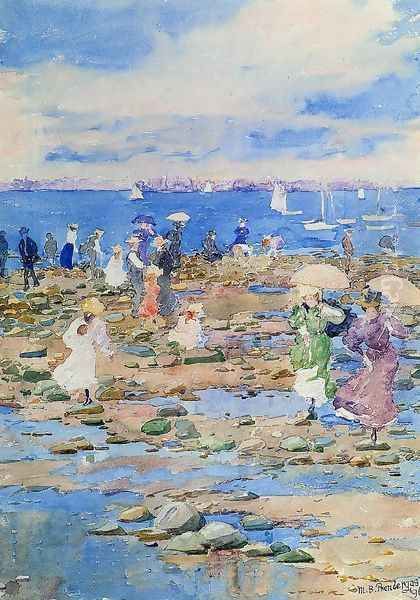
His health began to decline in his later years. He suffered from increasing deafness, which may have contributed to his somewhat withdrawn nature. Despite these challenges, and later battling the prostate cancer that would eventually claim his life, he remained remarkably productive. His dedication to his art was unwavering.
Throughout this period, his close relationship with his brother Charles remained crucial. Charles, an accomplished artist and craftsman in his own right, was also Maurice's steadfast supporter, business manager, and companion. Charles's intricately carved and gilded frames often complemented Maurice's paintings, reflecting a shared aesthetic sensibility. They lived and worked together until Maurice's death. Maurice Brazil Prendergast passed away in New York City on February 1, 1924, at the age of 65.
Influences and Connections
Maurice Prendergast's art was shaped by a rich tapestry of influences and connections within the art worlds of Europe and America. His time in Paris was formative, exposing him directly to the currents of Impressionism and Post-Impressionism. Key influences from this period include:
Impressionists: Edgar Degas, for his innovative compositions capturing modern life, and Camille Pissarro, for his depictions of bustling street scenes. The general Impressionist interest in light and contemporary subject matter provided a foundation.
Post-Impressionists: Paul Cézanne's emphasis on structure and building form with color patches resonated deeply, particularly in Prendergast's later work. The decorative qualities and flattened perspectives of the Nabis painters, especially Pierre Bonnard and Édouard Vuillard, were profoundly influential on his tapestry-like style. The bold color experiments of Henri Matisse, a leader of Fauvism, also find echoes in Prendergast's vibrant palette, though Prendergast's application was typically more controlled.
James Abbott McNeill Whistler: The American expatriate's emphasis on aesthetic harmony and tonal arrangements likely appealed to Prendergast's decorative sensibilities.
Italian Art: His trips to Italy exposed him not only to the landscape but also to early Italian Renaissance frescoes and Byzantine mosaics, whose flattened perspectives and decorative richness may have reinforced his stylistic inclinations.
In America, Prendergast was connected with key figures and groups:
The Eight: His association with Robert Henri, John Sloan, William Glackens, George Luks, Everett Shinn, Ernest Lawson, and Arthur B. Davies placed him within the circle of progressive artists challenging the National Academy of Design. Though stylistically distinct from the Ashcan School core, his modern spirit aligned him with their cause.
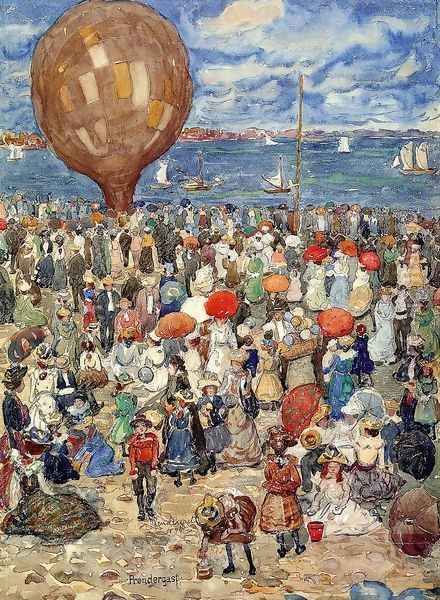
American Impressionists: While his style evolved beyond Impressionism, he was a contemporary of American Impressionists like Childe Hassam and Mary Cassatt. Cassatt, another American who studied in Paris and absorbed Impressionist lessons (particularly from Degas), shared an interest in depicting modern women and children, though her style remained more representational.
Alfred Stieglitz Circle: While not formally part of Stieglitz's group (which included modernists like Georgia O'Keeffe, Marsden Hartley, and John Marin), Prendergast's modernism existed concurrently with their explorations, contributing to the diverse landscape of early American Modernism.
Prendergast's unique synthesis of these influences resulted in a style that stood apart, admired by fellow artists like William Glackens, who shared some stylistic affinities, and recognized by collectors such as Albert C. Barnes and John Quinn, who were champions of modern art.
Legacy and Critical Reception
Maurice Brazil Prendergast holds a secure and respected place in American art history as a pioneering modernist and one of the foremost American Post-Impressionists. His unique style, characterized by its mosaic-like application of color, flattened decorative patterns, and joyful depictions of modern leisure, distinguishes him from his contemporaries. He successfully translated the advanced color theories and compositional ideas of European Post-Impressionism into a distinctly American idiom.
During his lifetime, critical reception was mixed. While progressive critics and fellow artists admired his work, more conservative viewers often found his style too radical, decorative, or lacking in traditional finish and narrative depth. His participation in The Eight exhibition and the Armory Show solidified his position among the avant-garde, but his gentle, optimistic subject matter set him apart from the often more confrontational or abstract tendencies of later modernism.
After his death, his reputation grew steadily. Curators and art historians came to appreciate the sophistication of his formal innovations and his unique contribution to the development of modern art in the United States. He is recognized as a crucial bridge figure, absorbing European influences while maintaining a personal vision focused on the American scene. His mastery of watercolor and monotype is particularly celebrated, alongside the rich, tapestry-like quality of his later oils.
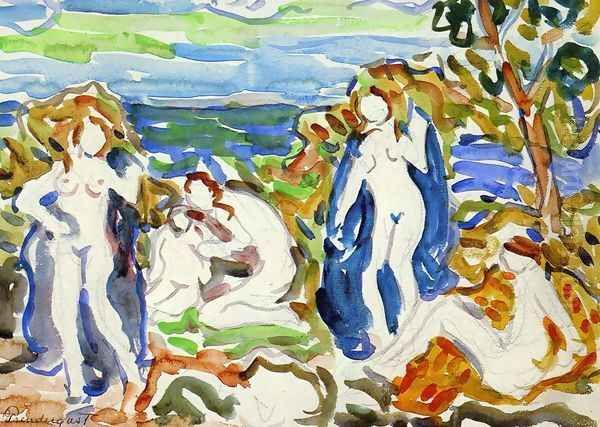
Today, Prendergast's works are held in the collections of virtually every major American art museum, including the Metropolitan Museum of Art in New York, the Museum of Fine Arts, Boston, the Whitney Museum of American Art, the Phillips Collection in Washington D.C., and the Art Institute of Chicago. Numerous exhibitions and scholarly publications have explored his life and work, confirming his status as a major figure. His paintings, with their vibrant colors and scenes of idyllic leisure, continue to appeal to audiences for their visual beauty and evocative portrayal of a bygone era viewed through a distinctly modern lens.
Conclusion
Maurice Brazil Prendergast carved a unique path through the complex landscape of turn-of-the-century art. Emerging from a background in commercial design, he transformed himself through study and observation in Paris, absorbing the lessons of the European avant-garde. He returned to America not as an imitator, but as an innovator, forging a highly personal style that blended Post-Impressionist color and structure with a Nabis-inspired decorative sensibility. His focus on the public spectacles of modern leisure – parks, beaches, festive cityscapes – provided the subject matter for his vibrant, mosaic-like compositions.
Though associated with The Eight and a participant in the landmark Armory Show, Prendergast remained an independent figure, his optimistic, pattern-filled canvases distinct from both the gritty realism of the Ashcan School and the more radical abstractions emerging in Europe. His legacy lies in this unique synthesis: a body of work that celebrates the visual pleasures of the modern world through a sophisticated and joyous exploration of color and form. As a master of watercolor, an innovator in oil painting, and a key figure in introducing modernist ideas to America, Maurice Prendergast remains an essential and beloved artist in the American canon. His shimmering tapestries of life continue to enchant viewers, offering a timeless vision of leisure rendered with pioneering style.